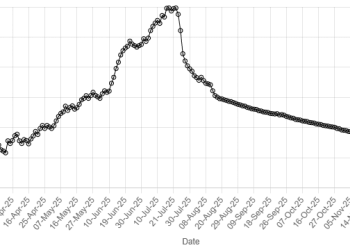HOUSTON: Oil prices edged lower on Wednesday after U.S. crude inventories rose unexpectedly and as worries that a wider Middle East conflict could threaten production in one of the world’s major regions for crude production eased slightly.
Brent crude futures slipped 41 cents, or 0.5%, to $80.28 a barrel by 10:36 a.m. ET (1436 GMT). U.S. West Texas Intermediate crude futures fell 55 cents, or 0.7%, to $77.77 per barrel.
U.S. crude inventories rose by 1.4 million barrels, compared with estimates for a 2.2 million barrel drop, data from the U.S. Energy Information Administration showed. Gasoline and distillate inventories fell more than expected.
Oil falls more than $1 as attack fears fade
American Petroleum Institute figures on Tuesday had pointed to a 5.21 million barrel drop last week.
Brent had risen more than 3% on Monday to cap a five-day run of gains, closing at $82.30 a barrel, after hitting a seven-month low of $76.30 at the beginning of last week.
Iran had vowed a severe response to the killing of the
leader of Hamas late last month. Three senior Iranian officials have said that only a ceasefire deal in Gaza would hold Iran back from direct retaliation against Israel for the assassination.
Israel has neither confirmed nor denied its involvement but it is fighting in Gaza against Hamas after the group attacked Israel in October. To counter Iran, the United States Navy has deployed warships and a submarine to the Middle East.
“Tighter supplies are well priced in,” said Dennis Kissler, senior vice president of trading at BOK Financial.
Also hindering oil price gains, the International Energy Agency trimmed on Tuesday its 2025 estimate for oil demand growth, citing the impact of a weakened Chinese economy on consumption. That came after OPEC cut expected demand for 2024 for similar reasons.
A recent string of dismal indicators have dulled expectations for China’s economic performance in July, in an ominous sign for the rest of 2024 for the world’s second-largest economy.
However, U.S. consumer prices rose moderately in July and the annual increase in inflation slowed to below 3% for the first time since early 2021, further strengthening expectations the Federal Reserve will cut interest rates next month.









